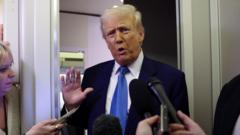This article delves into the implications of Donald Trump's tariff strategy, focusing on key trade relationships with countries like China, Canada, and Mexico, while considering potential economic impacts.
**Trump's Tariff Strategy: Impacts and Underlying Motives**

**Trump's Tariff Strategy: Impacts and Underlying Motives**
Exploring the reasons and consequences behind Trump's proposed tariffs on imports.
US President Donald Trump has announced significant tariffs on imports of steel and aluminum as part of his strategy to reshape the United States' trading relationships. This decision particularly affects Canada, the largest supplier of aluminum to the US, while also creating a ripple effect on trade with Mexico. Trump has implemented a 10% tariff on goods from China, which has retaliated with its own tariffs. The president argues that these tariffs are necessary for safeguarding the US economy and protecting against issues like illegal immigration and drug trafficking, though economists warn that such tariffs could lead to increased prices for American consumers.
Tariffs function as taxes levied on imported goods, where importing companies pay these fees to the government. For instance, a $10 product from China would incur an additional $1 charge due to the 10% tariff. Trump initially aimed for a 25% tariff on products from Canada and Mexico but opted for a temporary pause after negotiating border security agreements with both countries. The rationale behind these tariffs is tied to a commitment made during his campaign to impose import duties on key trading partners. Trump posits that tariffs could revitalize US manufacturing, protect American jobs, and boost tax revenues.
Specifically targeting the metals industry, Trump justifies these tariffs as a national security measure, implicating that materials from China are linked to the production of fentanyl, a drug causing widespread overdose deaths in the US. However, Canadian Prime Minister Justin Trudeau contends that a disproportionately small percentage of fentanyl originates from Canada.
The landscape of the tariffs is complex; China, Canada, and Mexico collectively represented over 40% of US imports last year. After the introduction of the 10% tariff on Chinese goods, China retaliated with tariffs of its own on American products, illustrating the tit-for-tat nature of the trade tensions. In negotiations with Canada, both powers have opted to defer tariff implementation, underscoring the tenuous state of their trade relations. Similar delays have been observed with Mexico, as both countries seek enhanced border security to address drug trafficking concerns.
Should the tariffs against Mexico and Canada be enforced, a range of commodities could see price increases. For instance, car manufacturing – which heavily relies on components crossing borders among the US, Canada, and Mexico – may face significant cost escalations, with potential increases to vehicle prices reaching up to $3,000. Items like fruit, vegetables, and Canadian-produced grains and potatoes are also likely to be affected.
The prospect of tariffs extends beyond immediate neighbors, with Trump implying that the UK and EU might face similar measures. The UK, which exports more to the US than it imports, has expressed hope for exclusion from such tariffs. However, Trump claims that the US has suffered a significant trade deficit with the EU, leading him to propose tariffs as a remedy. In the face of these developments, the EU has warned of firm responses to US tariff implementations.
Economists have voiced concerns that these tariffs may lead to inflationary pressures within the US economy. Higher import taxes often lead suppliers to adjust their prices to compensate for increased costs, with some analysts predicting that tariffs on various products could elevate the annual inflation rate significantly.
As Trump continues to navigate these trade policies, the delicate balance among international relations and domestic economic stability forms a crucial backdrop to the unfolding story of tariffs and their broader implications.






















